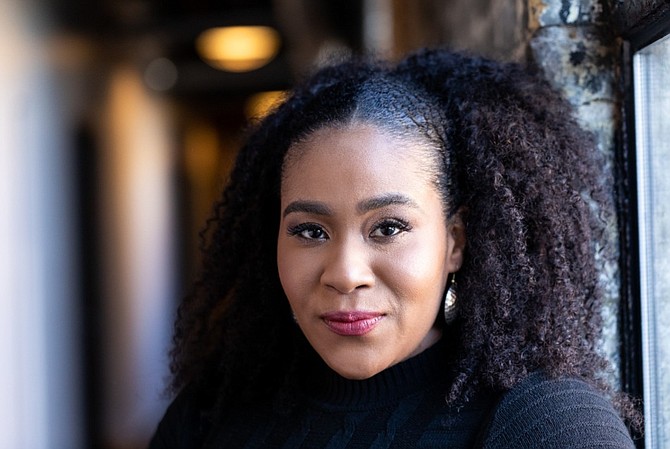INDIE FILMMAKER’S FEATURE LENGTH DOC AVAILABLE ON HBO MAX
Tyshun Wardlaw, owner of Wardlaw Productions, is the indie fi lmmaker behind “Growing Up Milkwaukee,” a documentary that is available on HBOMax. Photo provided by Felicia Apprey
BY TIA CAROL JONES
The documentary “Growing Up Milwaukee” begins with footage of the 2016 Sherman Park Riot and the words of Muhibb Dyer, co-founder of Flood the Hood with Dreams, from a 2007 Poetry Unplugged. Then Dyer, in current times talks about the media and statistics and the reality and truth of young Black men and women in Milwaukee.
“Growing Up Milwaukee” follows three young people: Marquell Jenkins, Tiana Gee and Brandon Haney. The feature-length documentary, from Tyshun Wardlaw, owner of Wardlaw Productions is available on HBOMax.
Wardlaw six years ago was moving between freelancing opportunities, both in Chicago and Los Angeles, and she knew she wanted to focus on her own content.
“I knew there was a purpose that was greater than what I was doing. Yet and still, in the film and television aspect of things. Then, I decided, I was going to be my own contract and I started Wardlaw Productions,” she said.
Wardlaw, who is a native of Milwaukee, said with her production company, she wanted to shed light on different issues and focus on stories that brought awareness. She wanted to focus on stories that were going on in Milwaukee.
“One thing I noticed, over the years as I commuted between states, I noticed that unfortunately the statistics that were coming out of the Black community in Milwaukee were staggering, in a negative way,” she said, adding that Milwaukee was ranked one of the five worst places for Black people to live and grow up in.
Wardlaw said incarceration rates were high among Black and brown people there, and education rates were low.
“I wanted to be able to go behind what was being told about the statistics and actually humanize the stories. But, I wanted to look at it from a youth perspective, because I wanted to see what does it mean for youth right now growing up in the city of Milwaukee,” she said.
Wardlaw said it took about two years to get established and once she got her large amount of funding, she started filming in 2018. She said she was introduced to the three young people featured by youth-based organizations.
Wardlaw said she wanted to go into stories that would shed light on some of the statistics. Wardlaw met Haney, who was getting out of a youth detention center and had two strikes against him.
“We wanted to be able to explore what does that mean, ‘two to three strikes you’re out’ to have a previous record, even at 15. Also, now you’re getting introduced to a whole ‘nother setting because at the time he left the detention center and he was put into a group home setting,” he said.
With Gee, Wardlaw met her when she was 18 and was aging out of a group home setting. She was 18, she was on her own, low-income and a young single mother who had a son at 14. Gee lost custody of her son but still had access to him.
“We were exploring what it meant for her to find her way in the world. Actually getting out there and doing what she needed to do, and also, exploring her gifts,” Wardlaw said about Gee who is a singer and writer. “We wanted to introduce her to organizations that have been around, in existence in Milwaukee, for the last 10 years and a lot of youth don’t even know they have access to these organizations to help guide and nurture their gifts.”
Wardlaw said with the distribution from HBO, she felt it was very purposeful. It accomplished what Wardlaw set out to do when she created the documentary.
“I wanted to be able to tell the story and humanize the stories behind the statistics, but I wanted to do that, on a National level, because the statistics are National. We see that on a National level, so we should have access to a story to say all hope isn’t lost,” she said, adding that as an indie filmmaker and this being her first feature film, she was excited to get National distribution through HBO. “It was in full alignment in what I originally set out to do when I decided I wanted to tell the story of what was happening in the city of Milwaukee with the Black youth.”
Wardlaw said she hopes people see that all hope is not lost for the Black youth she features and the rest of the Black youth in the city of Milwaukee.
“There are individuals and organizations that are working day in and day out to change the narrative of what is happening in the city. And also, to create our own. Because, if we don’t have access to tell our stories in its entirety, the good the bad and the ugly, people will never know,” she said.
Wardlaw is looking to use her production company to create network films. She said Chicago has great film incentives. She said she is hoping to be a vehicle, as a Black woman owned production company, to create studio projects, as well as her own content, and have it be filmed right here in Chicago.
Latest Stories
- Reminder: Taxes are due December 15, 2025. Pay now to avoid late fees. Struggling financially? Our Payment Plan Calculator is a tool you can use
- TWO GOVERNMENTS TO FORMALIZE HISTORIC PARTNERSHIP IN ADDRESSING MENTAL HEALTH CRISIS DURING THE HOLIDAY SEASON
- Trump's Policies Negatively Target Women
- Assessor Kaegi, South and West Side Community Leaders Urge Legislature to Pass Property Tax Relief, Condemn Board of Review's Large Breaks for Downtown Commercial Properties
- State Farm and The Salvation Army Launch National Donation Drive to Support Families This Holiday Season
Latest Podcast
Stacy Davis Gates

